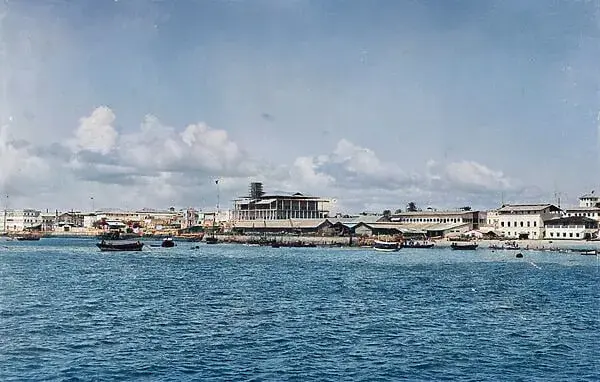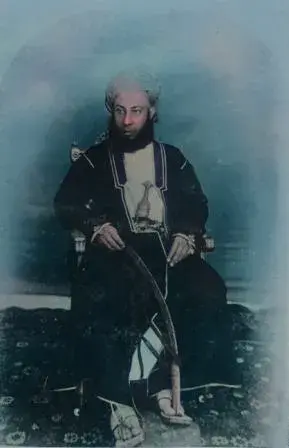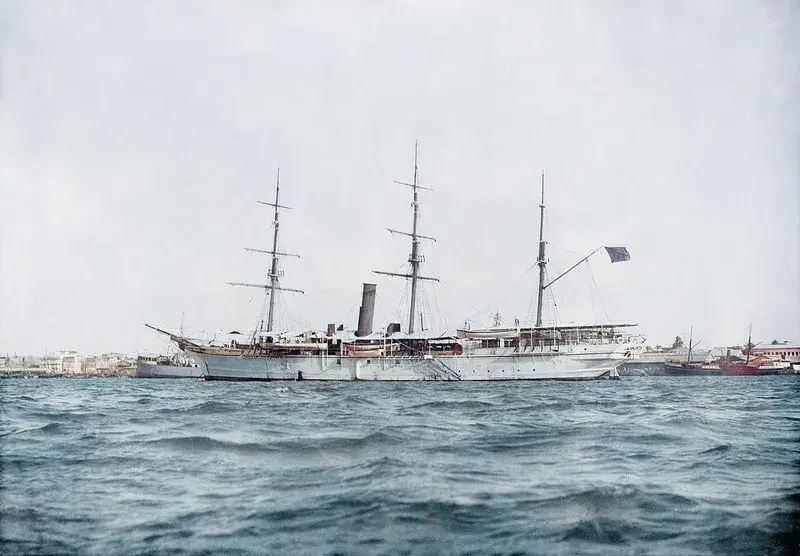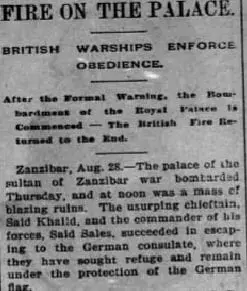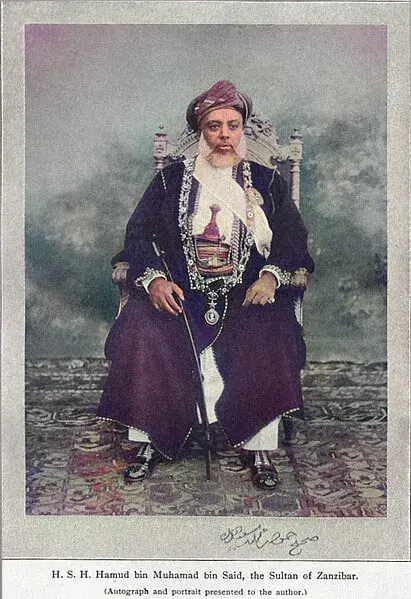At the turn of the 19th and 20th centuries, a rapid but notorious conflict broke out in East Africa — the Anglo-Zanzibar War of 1896. Imagine a modern-day drone strike against the Roman legionaries. This is the best analogy to the British gunboat bombardment of the Sultan's palace that lasted for 38 minutes. A historic case of complete annihilation of the opposing party that shaped colonial dynamics in Africa.
In this article, we'll explore the story and facts about the war, including the rationales and the repercussions that came from this quick conflict. So buckle up for a fast tour of the Anglo-Zanzibar War, where imperial ambitions collided with the local ambition for sovereignty.
As we look into this unique and significant conflict, we'll also take you through the brief history of Omani and British control in Zanzibar, explain the full account of the war, and illustrate how the Scramble for Africa shuffled the cards of colonial realities.
Finally, we'll wrap it up with a Top-5 war-related places to visit in Zanzibar.
Where Is Zanzibar?
Zanzibar is an archipelago nestled in the turquoise waters of the Indian Ocean. It is located just off the East African coast of modern-day Tanzania. Zanzibar Island (officially known as "Unguja") is the second largest in the archipelago and cedes in size only to its larger brother Pemba Island. Overall, Zanzibar is a hilly tropical beauty with picturesque landscapes and an average annual temperature of +25.7°C.
Omani Zanzibar before the British influence
In 1498, the renowned Portuguese explorer Vasco da Gama was the first European to set foot on Zanzibar. In a few years, the island became part of the Portuguese Empire. New European rulers established the governing system of sultans of Zanzibar. They were the local elite Swahili merchants.
In the early 18th century, the Portuguese were expelled from the region by the Omani Empire that controlled most of the Eastern African coast from Mogadishu to Kilwa in present-day Somalia and southern Tanzania. Zanzibar became an integral part of the Omani Empire, ruled by hakims (local governors).
The sultans and hakims represented the interests of the local population. In contrast, the colonizers were mainly interested in resource consumption and trade. Sooner or later such a disparity between the locals and the overseas rulers was bound to lead to conflict.

Zanzibar's colonial economy
The 19th century marked a period of prosperity for Zanzibar. The Omani Empire moved its official capital to Zanzibar's Stone Town in 1840. The perfect warm and sunny climate of this East African Island, positively impacted clove, spice, and other agricultural exports.
The clove plantation boom used slave labor and led to the creation of one of the largest slave markets of its time. Zanzibar's geographical position at the intersection of ship routes from the Middle East, India, and South East Asia was ideal for trade. Merchants and caravans from across the globe visited Zanzibar in search of slaves and scarce resources precious among European consumers. Zanzibar was gradually integrating into the world's first truly globalized economy.
Building upon this economic success, the island became independent of Muscat and Oman in 1861 led by the first Sultan of Zanzibar Majid bin Said.
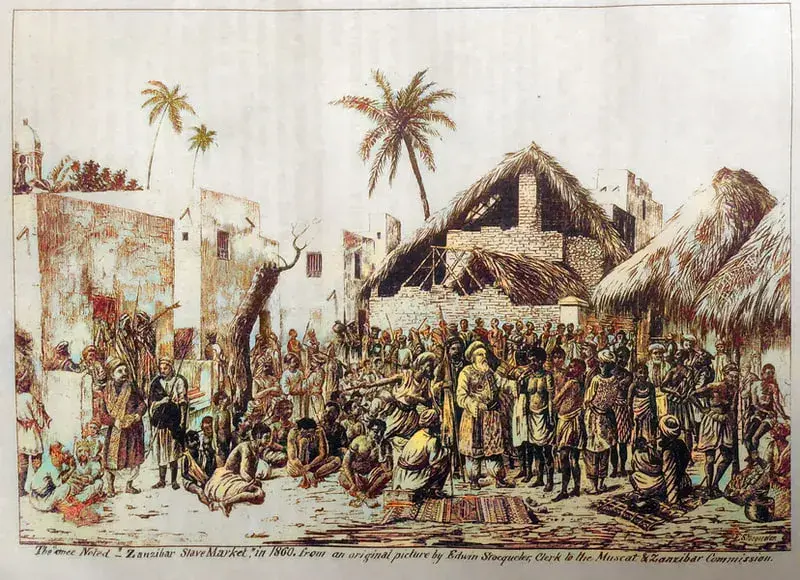
British Empire on Zanzibar
Preceded by the USA, the British Empire marked official interest in Zanzibar in 1841 by establishing a Consulate on the island. The British were later joined by the French and Germans. However, only Great Britain succeeded in keeping friendly relations and influence over the sultans of Zanzibar between 1870 and 1890. During this period, both Sultan Barghash bin Said and his successor Khalifa bin Said developed infrastructure and took steps to restrict the slave trade on Zanzibar.
What was the British interest in Zanzibar?
Britain had several motivations for establishing a permanent presence in Zanzibar. Economically, ruling over Zanzibar guaranteed maintaining a monopoly on the global production of olive oil and clove trade, a valuable spice used in industries including food, medicine, and perfumery. Additionally, Zanzibar was a perfect location for the naval base for controlling East African and East Indian Ocean waters.
The British also sought to protect British Indians and other subjects from involvement in the illegal slave trade, which thrived in the region. Lastly, controlling the crossroad of crucial trade routes and access to the resource-rich mainland of East Africa helped counter German expansion in Africa.
The Anglo-German treaties in East Africa
Zanzibar's formal transformation into a British colony stemmed from the Seeking to settle outstanding colonial disputes, Britain and Germany signed the Heligoland-Zanzibar Treaty in 1890. Germany relinquished its claims to Zanzibar and Pemba in exchange for the British island of Heligoland in the North Sea. The Germans acquired the Caprivi Strip, a narrow corridor linking German South West Africa to the Central African Zambezi River. Official colonization coincided with the rise of a new imperial ideology introduced by John Ruskin, an English writer and philosopher, stated on 8 February 1870: "There is a destiny now possible for us, the highest ever set before a nation...This is what England must do or perish". Britain imaged itself as the "civilizing" power across the globe. The treaty marked the emergence of a conflict of interest between the local elites and British colonial policies, laying the groundwork for future unrest.
The Heligoland-Zanzibar Treaty followed the Anglo-German Agreement of 1886, which established the regional spheres of influence. Both powers agreed not to interfere in each other's spheres. Britain supported leased territories of Dar-es-Salaam and Pangani controlled by Sultan Barghash bin Said. In turn, Germany agreed to recognize Zanzibar's sovereignty. Before its formal colonization, Zanzibar held the status of a British protectorate. Most importantly, the British consul was given the right to veto the candidates for the Sultan throne.
How did the war begin?
The Anglo-Zanzibar war was directly caused by the succession struggle that followed the death of the pro-British Sultan of Zanzibar Hamad bin Thuwaini on the 25th of August 1896. It is widely believed he was poisoned by his nephew Khalid bin Barghash. The British authorities intervened and vetoed his candidacy for the throne. They feared Khalid's bin Barghash potential alliance with Germans and his pro-slavery position. The British diplomatic agent Arthur Hardinge insisted on Hamoud bin Muhammed becoming the new Sultan. In turn, Khalid seized power without British approval. He announced himself as the new Sultan of Zanzibar and captured the Sultan's palace and harem.
Khalid bin Bargash became the symbol of aversion to European interference. Representatives of the Arab ruling class who opposed the abolition of the valuable slave trade supported him. Some of the Zanzibari population backed Khalid as they resisted British interference in local traditions, politics, and culture. In addition, he managed to riot with the force of 1000 armed men loyal to the deceased Sultan of Zanzibar.
The diplomatic failure. Peaceful solution proving useless
In the late 19th century Great Britain stood as the worldwide hub of trade and finance, and the Royal Navy was the largest in the world. With unparalleled maritime dominance, the British were among the first states to use gunboat diplomacy to pursue national interests.
To use British forces against the usurper the British Consul named Basil Cave had to receive authorization from the British government. Khalid bin Bargash received several ultimatums offering him to leave the Sultan's palace, but all were rejected.
Her Majesty's government support for the use of military force was delivered via telegraph. The last British ultimatum expired at 9.00 on 27 August. Stone Town was about to witness the shortest war in recorded history. The conflict lasted from 38 to 45 minutes depending on the source and was preceded by messaging between Khalid bin Barghash and Basil Cave:
“We have no intention of hauling down our flag and we do not believe you would open fire on us” — said Khalid bin Barghash in his message to the Consul.
“We do not want to open fire, but unless you do as you are told we shall certainly do so” — replied Basil Cave.
British forces vs. Sultan's people
Rear Admiral Harry Rawson, Brigadier-General Lloyd Mathews and Lieutenant Arthur Edward Harington Raikes commanded The Royal Navy force. 150 British marines and sailors were aboard five warship cruisers: HMS Philomel, HMS St. George, and 3 gunboats: the HMS Racoon, HMS Thrush and HMS Sparrow. They were joined by 900 loyal Zanzibari askari warriors.
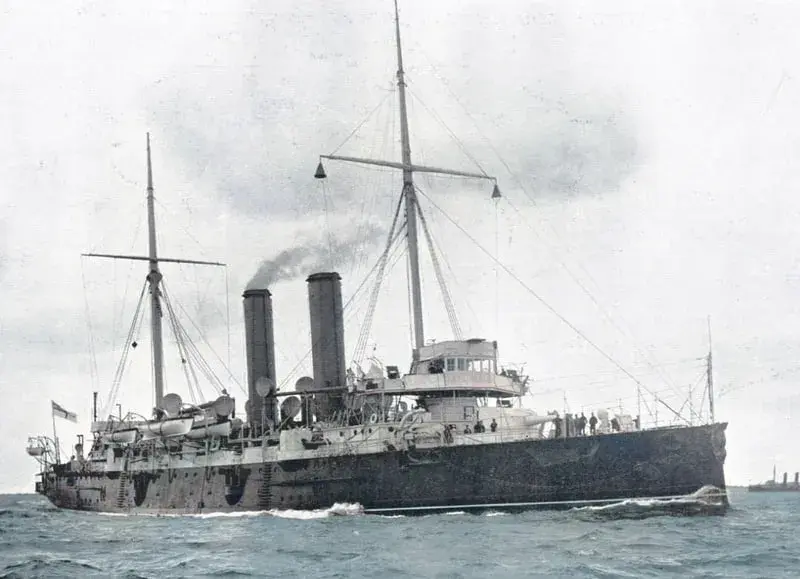
The sultan's forces were headed by Khalid bin Bargash. Around 2800 men with outdated rifles and muskets along with 700 askari soldiers guarded their next Sultan. His artillery consisted solely of presents from foreign states: 4 artillery pieces, a shore battery, several Maxim machine guns, a Gatling gun, a 17th-century bronze cannon, and two 12-pounder field guns. The rebels even had a navy: a flagship HHS Glasgow gifted from Queen Victoria built in 1878, 2 boats, and a wooden sloop.
How did the shortest war in history unfold?
Khalid bin Barghash barricaded himself and his forces in the palace. Captain Saleh from the palace guard placed artillery and machine guns at the British ships. As soon as the ultimatum expired at 09:00, the heavy bombardment with high explosive shells started at 9.02. In just minutes the Royal Navy forces unleashed a massive attack: 500 shells, 4,100 machine-gun rounds, and 1000 rifle rounds were shot at the Royal Palace and Harem.
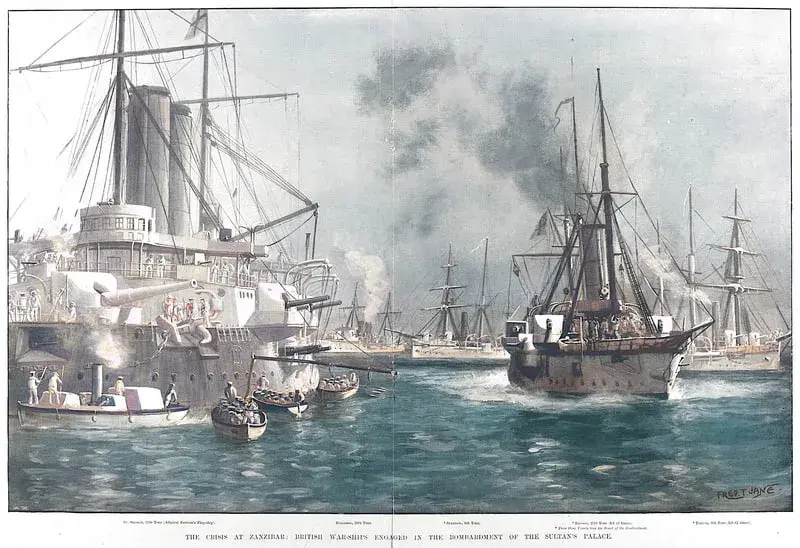
The defending artillery was disabled, HSS Glasgow was annihilated by the return fire from HMS St. George, and the palace was destroyed. At approximately 9.37 to 9.45 AM Khalid bin Barghash surrendered. Sultan's forces suffered 500 casualties in contrast to only one British sailor accidentally injured. The disparity between casualty numbers is not surprising. Some Zanzibari defenders rode into battle on bicycles.
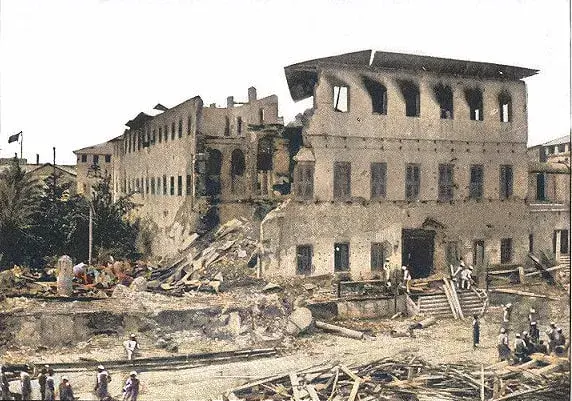
Aftermath of the war
The luckless usurper fled and sought refuge at the German Consulate because they did not give in political prisoners. The German authorities were afraid of violating diplomatic protocols during Khalid's bin Barghash evacuation. The German troops, the seaman of the Imperial German Navy carried ex-Sultan on the boat ensuring he wouldn't touch British soil. The German Consulate accomplished a mission impossible. Exiled to Dar es Salaam on the African mainland he never came back.
Meanwhile, pro-British Hamoud bin Mohammed ascended the Zanzibari throne, becoming the sixth Sultan. He abolished slavery and started a slow yet positive process of emancipation.
Significance of the war
Historically, such a short conflict holds little significance beyond its symbolic value as the shortest war in history. However, the war demonstrated the power of the Royal Navy and British gunboat diplomacy. It also highlighted the technological gap between the colonized African states and their European colonizers.
Politically, the use of brute force to suppress independence movements in Africa sparked anti-colonial debates and movements across the continent. Economically, the British-imposed economic structures in Zanzibar sowed the seeds of future inequality and underdevelopment, contributing to the struggles for postcolonial sovereignty. The most notable result was social — abolition of slavery brought more freedom to Zanzibaris.
The Anglo-Zanzibar War: A minor chapter in the Scramble for Africa.
The Berlin 1884-1885 Colonial Conference gathered imperial powers and aimed to end slavery and establish spheres of influence in Africa — the so-called Treaty System. The strive for colonies in Africa by the British, French, German, Belgian, Spanish, Portuguese, and Italian Empires was dictated by the global recession faced by European capitalism and caused by rising protectionism. They all craved new markets and lands to exploit for materials to meet their industrial demands.
As a result, 10,000 tribal kingdoms in Africa were divided between the European powers. British Prime Minister Lord Salisbury's comment on the Scramble on Africa in 1890: "We have been engaged in drawing lines upon maps where no white man's foot ever trod; we have been giving away mountains and rivers and lakes to each other, only hindered by the small impediment that we never knew exactly where the mountains and rivers and lakes were". best characterized the Scramble of Africa as "drawing lines". Only the ancient kingdoms of Ethiopia and Liberia remained independent thanks to the special relations with the United States.
The Anglo-Zanzibar war doesn't stand as a major chapter in the Scramble for Africa. However, even such a short war illustrates the dynamics of European imperialism. The British demands were solely imperial and provoked the conflict. The British government desired to control Zanzibar and the local elites strived for independence.
In the footsteps of the Zanzibar War of 1896
Planning to visit the site of the shortest war in history and relive the experience of the Royal forces or palace defenders? We've prepared a list of tourist attractions for you:
1. Stone Town: an epicenter of the war back then, the heart of Zanzibar, and a UNESCO World Heritage Site nowadays. Narrow streets, stone buildings, and bullet holes from the bombardment create an authentic atmosphere.
2. House of Wonders (Beit al-Ajaib): once the Sultan's palace, now restored from the shelling and serves as the National Museum of Zanzibar. Exhibits explore the country's history including the war through showcasing artifacts and weapons used during the conflict.
3. The Peace Memorial Museum: housed within the British Consulate building in Stone Town, this museum offers a comprehensive overview of the war. Learn about the war through exhibits, artifacts, photographs, and documents.
4. Chumbe Island:it was a popular retreat for Zanzibar's elite. During the war the British established a signal station there. Nowadays, the protected marine area is popular among divers. If you are one of them, check out our guide to the best diving sites in Tanzania.
5. The grave of Sultan Khalid bin Barghash: the Sultan's tomb in Matondoni, a village on the east coast of Zanzibar.














